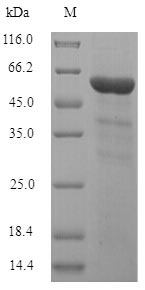To produce recombinant human Inositol polyphosphate-5-phosphatase A (INPP5A) in E. coli, the gene of interest (1-409aa of human INPP5A) is first co-cloned into an expression vector with an N-terminal 6xHis-SUMO-tag gene and transformed into E. coli cells. These cells are cultured to promote protein expression. Once sufficient growth is achieved, the cells are lysed, releasing the recombinant protein. The recombinant human INPP5A is purified from the cell lysate through affinity chromatography. The purity of the protein is checked using SDS-PAGE, exceeding 90%.
Human INPP5A is a vital enzyme involved in cellular signaling pathways and various diseases. It primarily functions as a signal-terminating enzyme associated with cell proliferation [1]. INPP5A is a member of the inositol polyphosphate 5-phosphatase family, which is involved in terminating downstream signaling of phosphatidylinositol-3 kinase [2]. Research indicates that INPP5A negatively regulates insulin signaling and glucose homeostasis in specific tissues [3]. Variations in the INPP5A gene have been linked to differences in cognitive abilities [4]. Evidence has shown that INPP5A is a prognostic marker in cutaneous squamous cell carcinoma, where it negatively regulates inositol signaling [5]. Loss of INPP5A has been identified as an early event in the development of cutaneous squamous cell carcinoma [6]. Furthermore, INPP5A has been implicated in melanomas, acting as a tumor suppressor by regulating PI3K/Akt signaling [2].
References:
[1] M. Yang, Z. Xu, T. Ge, C. Yang, & G. Lou, Mir-181a-5p promotes proliferation and invasion and inhibits apoptosis of cervical cancer cells via regulating inositol polyphosphate-5-phosphatase a (inpp5a), Oncology Research Featuring Preclinical and Clinical Cancer Therapeutics, vol. 26, no. 5, p. 703-712, 2018. https://doi.org/10.3727/096504017x14982569377511
[2] Y. Yan, L. Jin, J. Wilmott, H. Wang, B. Yosufi, R. Thorneet al., Pi(4,5)p2 5-phosphatase a regulates pi3k/akt signalling and has a tumour suppressive role in human melanoma, Nature Communications, vol. 4, no. 1, 2013. https://doi.org/10.1038/ncomms2489
[3] L. Ooms, K. Horan, P. Rahman, G. Seaton, R. Gurung, D. Kethesparanet al., The role of the inositol polyphosphate 5-phosphatases in cellular function and human disease, Biochemical Journal, vol. 419, no. 1, p. 29-49, 2009. https://doi.org/10.1042/bj20081673
[4] I. Deary, S. Cox, & W. Hill, Genetic variation, brain, and intelligence differences, Molecular Psychiatry, vol. 27, no. 1, p. 335-353, 2021. https://doi.org/10.1038/s41380-021-01027-y
[5] M. Patel, C. Brumfiel, K. Severson, D. DiCaudo, S. Nelson, R. Butterfieldet al., The prognostic value of inositol polyphosphate 5‐phosphatase in cutaneous squamous cell carcinoma in the general population, International Journal of Dermatology, vol. 60, no. 10, 2021. https://doi.org/10.1111/ijd.15565
[6] A. Sekulić, S. Kim, G. Hostetter, S. Savage, J. Einspahr, P. Sagermanet al., Loss of inositol polyphosphate 5-phosphatase is an early event in development of cutaneous squamous cell carcinoma, Cancer Prevention Research, vol. 3, no. 10, p. 1277-1283, 2010. https://doi.org/10.1158/1940-6207.capr-10-0058




